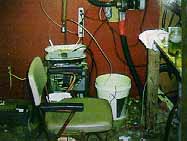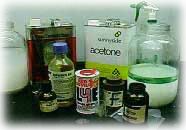What is
Methamphetamine
A drug with immense abuse
potential, methamphetamine (known on the street as "speed," "meth,"
"crank," "crystal-meth," and "glass") is a central nervous
system stimulant of the amphetamine family. Like cocaine, it is a powerful
"upper" that produces alertness, and elation, along with a variety of adverse
reactions. The effects of methamphetamine, however, are much longer lasting then the
effects of cocaine, yet the cost is much the same. For that reason, methamphetamine is
sometimes called the "poor man's cocaine."
As with many drugs, methamphetamine, if
prescribed by a physician, is legally available in the United States for the treatment of
attention deficit disorders and obesity. Unfortunately, much of the methamphetamine
available on the street is illicit methamphetamine from clandestine laboratories in the
United States.
Production originally concentrated in
clandestine labs throughout the Western and Southwestern United States, but has spread to
the Central United States and beyond. In addition to the clandestine laboratories in the
United States, organized crime groups in Mexico appear responsible for increased
methamphetamine production on both sides of the border during the 1990's.
Is
there Methamphetamine in
Kansas?
Law enforcement and
substance abuse centers in Kansas have observed an increase in the prevalence of
methamphetamine. The Kansas Alcohol and Drug Abuse Services reported an increase of 359%
in methamphetamine primary problem admissions from Fiscal Year 1994 to Fiscal Year 1997.
The Kansas Highway Patrol reported Interdiction Unit seizures for methamphetamine
increasing from 1994 to 1997 ' Clandestine laboratory seizures reported to the Kansas
Bureau of Investigation and Drug
Enforcement Agency in Kansas have also
increased over the same period, as can be seen in the chart below. These seizures reflect
reported occurrences throughout the State of Kansas, not just the metropolitan areas.
|
KHP Seizures
(in pounds) |
Clandestine
Labs Seized |
| 1994 |
6.9 |
4 |
| 1995 |
9.9 |
7 |
| 1996 |
21.5 |
71 |
| 1997 |
59 |
99 |

What
is a
CLANDESTINE LABORATORY?
A
clandestine laboratory is a
laboratory used for the primary purpose of illicitly (illegally) manufacturing controlled
substances, such as cocaine and methamphetamine. Clandestine labs are typically small,
utilizing common household appliances, glassware, and readily available chemicals. While
some clandestine laboratories may be located in industrial areas, they are most frequently
located in residential areas.
There are many different methods for
producing methamphetamine. Each method has its own inherent dangers. Many of the chemicals
used are caustic or corrosive, and some of the processes create noxious and harmful fumes.
Additionally, many of the chemicals can be
found in common household items such as lantern fuel, cleaners, acetone, muriatic acid,
and diet pills.
What
are the
DANGERS?
Clandestine
laboratories present numerous hazards to people and the environment. Extreme potential for
fires, explosions, and exposure to hazardous chemicals and fumes are but a few.
Additionally, clandestine labs are considered hazardous waste sites and should only be
entered by trained and equipped professionals. Anyone finding a clandestine laboratory
should leave it alone and immediately contact local law enforcement or the Kansas Bureau
of Investigation at 1-800-KS CRIME |

How is it
TAKEN?
Methamphetamine can be ingested, inhaled,
or injected. It is sold as a powder or in small chunks which resemble rock candy. It can
be mixed with water for injection or sprinkled on tobacco or marijuana and smoked. Chunks
of clear, high-purity methamphetamine ("ice," "crystal,"
"glass") are smoked in a small pipe, much as "crack" cocaine is
smoked. Since methamphetamine will vaporize rapidly, some heat the drug and inhale the
fumes that are released.
What are the
SYMPTOMS OF USE?
Some of the symptoms of methamphetamine use are:
- Sleeplessness
- Loss of appetite and weight loss
- Nausea, vomiting, diarrhea
- Elevated body temperature
- Skin ulceration and infection, the result of picking at
imaginary bugs
- Paranoia
- Depression
- Irritability
- Anxiety
- Increased blood pressure
- Seizures
- For pregnant women - premature labor, detachment of the
placenta, and low birth weight babies with possible neurological damage.
- For intravenous (I V) users - AIDS, hepatitis,
infections and sores at the injection site, and infection of the heart lining and valves.

METH
vs. COCAINE?
Methamphetamine is generally cheaper than
cocaine and - because the body metabolizes it more slowly - much longer lasting.
Methamphetamine's effects may last as much as ten times longer than a cocaine user's high.
With its long-lasting effects, methamphetamine binges may last up to a week, while cocaine
binges rarely continue for more than 72 hours. When heavy cocaine users experience
paranoia, it almost always disappears once the binge ends. For methamphetamine users,
however, severe disturbance of mood and thought may be sustained well beyond the binge.
Not infrequently, they persist for days, sometimes weeks. Similarly, the methamphetamine
crash is more prolonged, and drug-related depression that users may experience upon
awakening can be more severe than any experienced by cocaine users.
What
is
HIDTA?
In December 1996, the
Office of National Drug Control Policy (ONDCP), Executive Office of the President of the
United States, designated identified counties in Iowa, Kansas, Missouri, Nebraska, and
South Dakota as the
Midwest High Intensity Drug Trafficking Area
(HIDTA). The designation including Kansas resulted from Kansas seeing an explosion in
the clandestine manufacturing of methamphetamine by small entrepreneurial users/dealers,
primarily utilizing the ephedrine or pseudoephedrine reduction process. Additionally, with
the interstate highway system and air/rail hub infrastructure, organizations utilize the
Central United States for importation and distribution.
HIDTA is a consortium of law enforcement,
prosecution, forensic laboratory and demand reduction professionals who are combining
resources and expertise to combat the increase in methamphetamine trafficking and
production.
HIDTA was established to promote
investigator safety, reduce duplicative efforts, and increase coordination, cooperation,
and technological advancement. The mission of the Midwest HIDTA is to
reduce and disrupt the importation, distribution, and
clandestine manufacture of methamphetamine in the five
state region. |